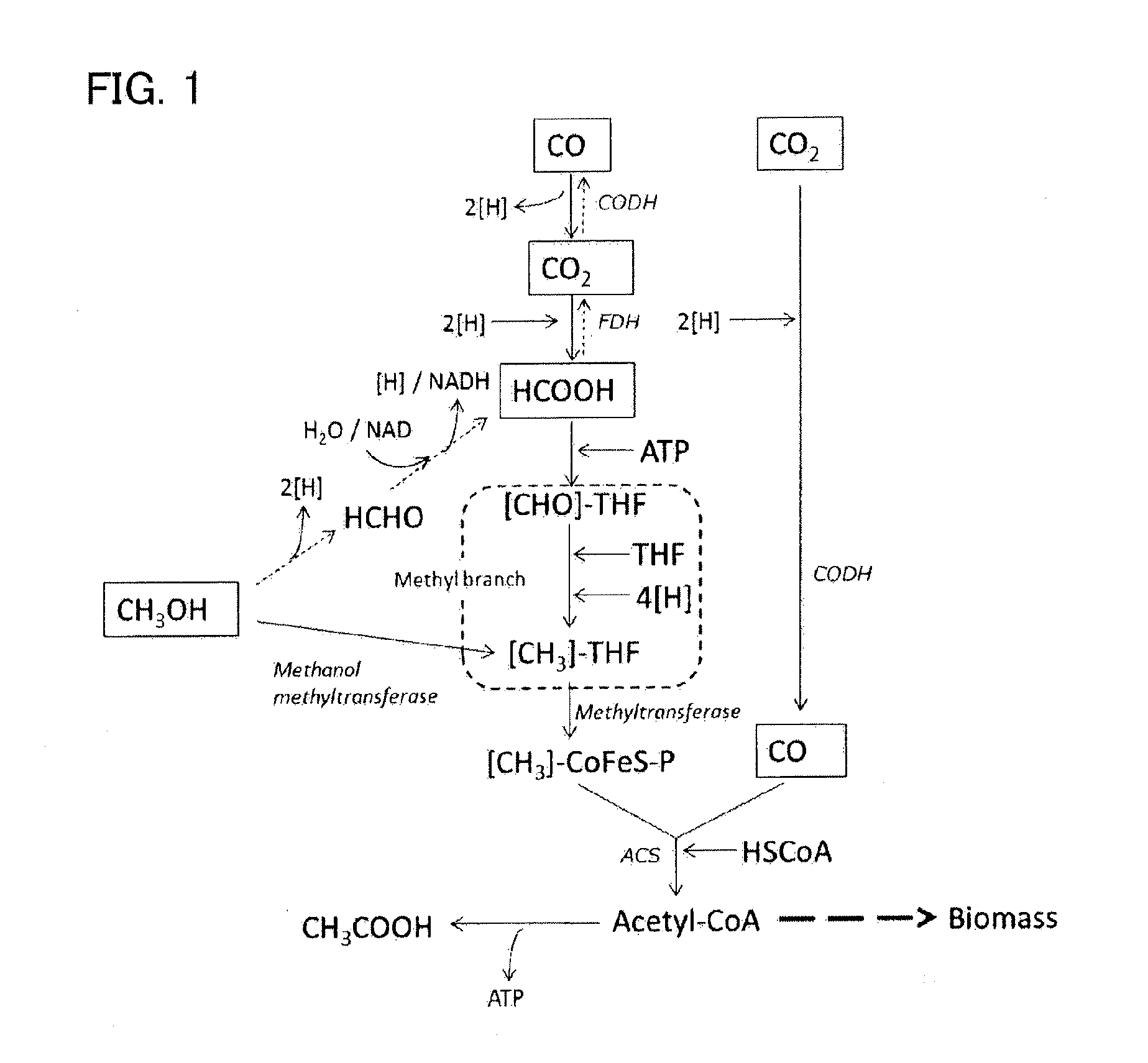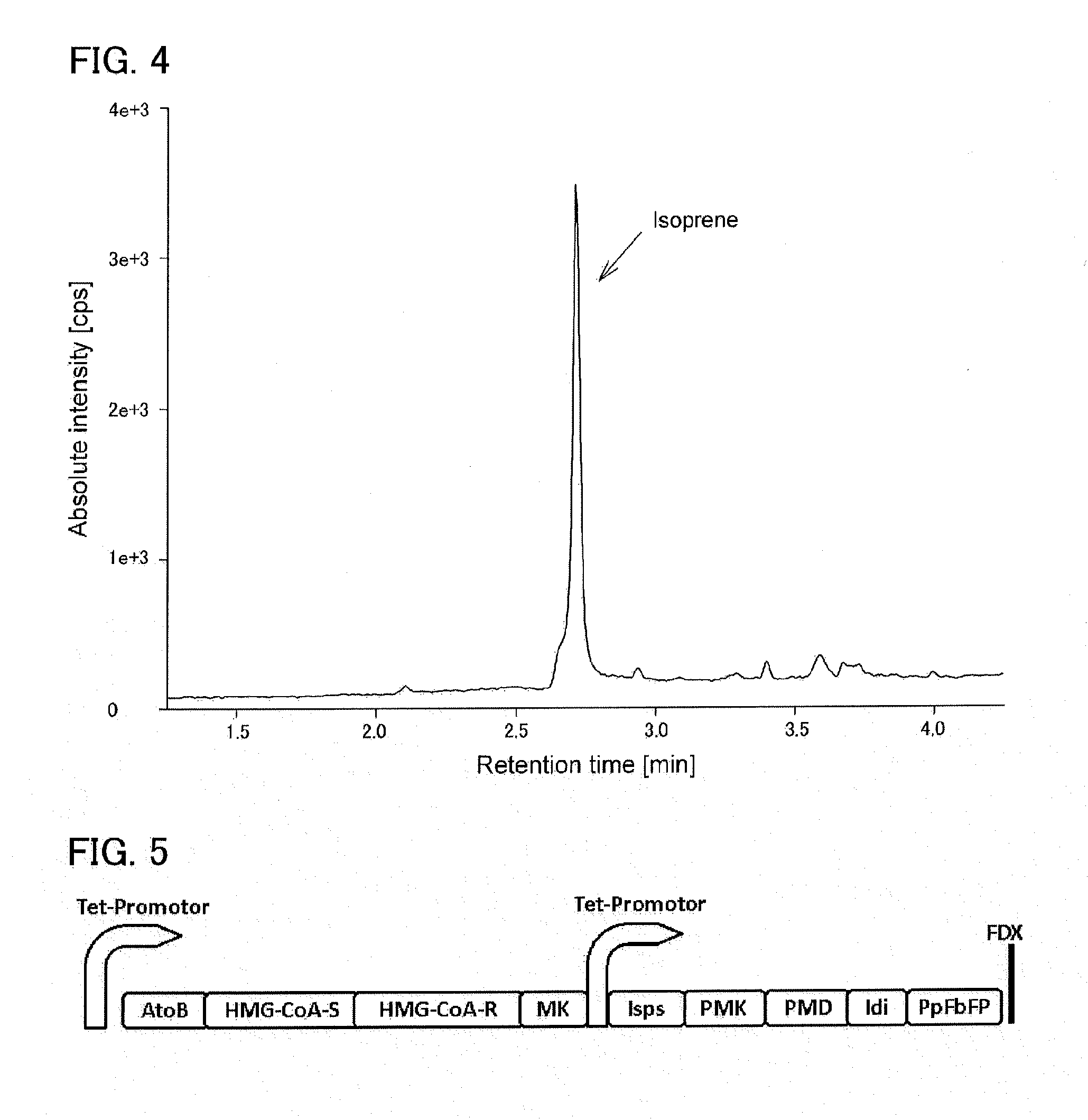Recombinant cell, and method for producing isoprene
a recombinant cell and isoprene technology, applied in the field of recombinant cell and isoprene production method, can solve the problems of insufficient quantities of saccharides, glycerin and oil components derived from plant resources and the like that are currently available, and the production quantity of basic chemicals by microorganisms relying on saccharides or oil components is limited, and the process also has a fear of competition with foods
- Summary
- Abstract
- Description
- Claims
- Application Information
AI Technical Summary
Benefits of technology
Problems solved by technology
Method used
Image
Examples
example 1
(1) Isolation of Isoprene Synthase Gene from Poplar, and Construction of Expression Vector
[0128]Using total RNA derived from leaf of poplar (Populus nigra) as a template, a nucleic acid encoding isoprene synthase (IspS) from poplar (IspS gene from poplar, SEQ ID NO: 1, GenBank Accession No.: AM410988.1) was amplified by RT-PCR using primers represented by SEQ ID NO: 3 and SEQ ID NO: 4. The obtained amplified DNA fragment was cloned into pT7-Blue T vector (TAKARA BIO INC.) to construct pT7IS.
[0129]On the other hand, in BamHI / EcoRI site of Clostridium / E. coli shuttle vector pIMP1 (Mermelstein L D et al., Bio / technology 1992, 10, 190-195), synthetic DNAs represented by SEQ ID NO: 5 and SEQ ID NO: 6 were introduced to modify the cloning site, to construct pIM1A. Further, in PstI / BamHI site of pIM1A, synthetic DNAs represented by SEQ ID NO: 7 and SEQ ID NO: 8 were introduced to construct pIM1B. The pT7IS was cut with BamHI to obtain IspS gene. The IspS gene was introduced into BamHI site...
example 2
(1) Construction of Expression Vector into which Mevalonate Pathway Enzyme Gene and Isoprene Synthase Gene were Introduced
[0135]Using genome DNA of Streptomyces griseolosporeus (Kitasatospora griseola) as a template, a nucleic acid encoding mevalonate pathway enzymes of S. griseolosporeus (SEQ ID NO: 9) was amplified by PCR using primers represented by SEQ ID NO: 10 and SEQ ID NO: 11. This nucleic acid includes a gene cluster encoding mevalonate kinase, mevalonate diphosphate decarboxylase, phosphomevalonate kinase, IPP isomerase, HMG-CoA (3-hydroxy-3-methylglutaryl coenzyme A) reductase (HMGR), and HMG-CoA synthase. The obtained amplified DNA fragment was cloned into pT7-Blue T vector to construct pT7SMV.
[0136]On the other hand, using pT7IS prepared in Example 1 as a template, a DNA fragment containing IspS gene from poplar was amplified by using primers represented by SEQ ID NO: 3 and SEQ ID NO: 12. This DNA fragment was cloned into pT7-Blue T vector to construct pT7IS2.
[0137]In B...
example 3
(1) Construction of Expression Vector into which Codon-Modified Isopentenyl Diphosphate Isomerase (IDI) Gene and Isoprene Synthase (IspS) Gene were Introduced
[0145]In the present example, production of isoprene by Clostridium ljungdahlii into which both codon-modified isopentenyl diphosphate isomerase (IDI) gene from Escherichia coli and isoprene synthase (IspS) gene from poplar were introduced was attempted. For codon modification, Codon Usage Table of Clostridium kluyveri (DSM 555) was referred (http: / / www.kazusa.or.jp / codon / cgi-bin / spsearch.cgi?species=c lostridium&c=i).
[0146]In PstI / BamHI site of pIM1A prepared in Example 1, codon-modified IDI-IspS operon synthetic gene (SEQ ID NO: 15, shown by sense strand) was introduced to construct an expression vector pIMAIS1. In the same manner, codon-unmodified IDI-IspS operon synthetic gene was introduced to construct an expression vector pIMAIS2.
[0147]In SEQ ID NO: 15, the part spanning nucleotide numbers 165 to 713 corresponds to codon...
PUM
| Property | Measurement | Unit |
|---|---|---|
| absolute pressure | aaaaa | aaaaa |
| pH | aaaaa | aaaaa |
| resistance | aaaaa | aaaaa |
Abstract
Description
Claims
Application Information
 Login to View More
Login to View More - R&D
- Intellectual Property
- Life Sciences
- Materials
- Tech Scout
- Unparalleled Data Quality
- Higher Quality Content
- 60% Fewer Hallucinations
Browse by: Latest US Patents, China's latest patents, Technical Efficacy Thesaurus, Application Domain, Technology Topic, Popular Technical Reports.
© 2025 PatSnap. All rights reserved.Legal|Privacy policy|Modern Slavery Act Transparency Statement|Sitemap|About US| Contact US: help@patsnap.com



